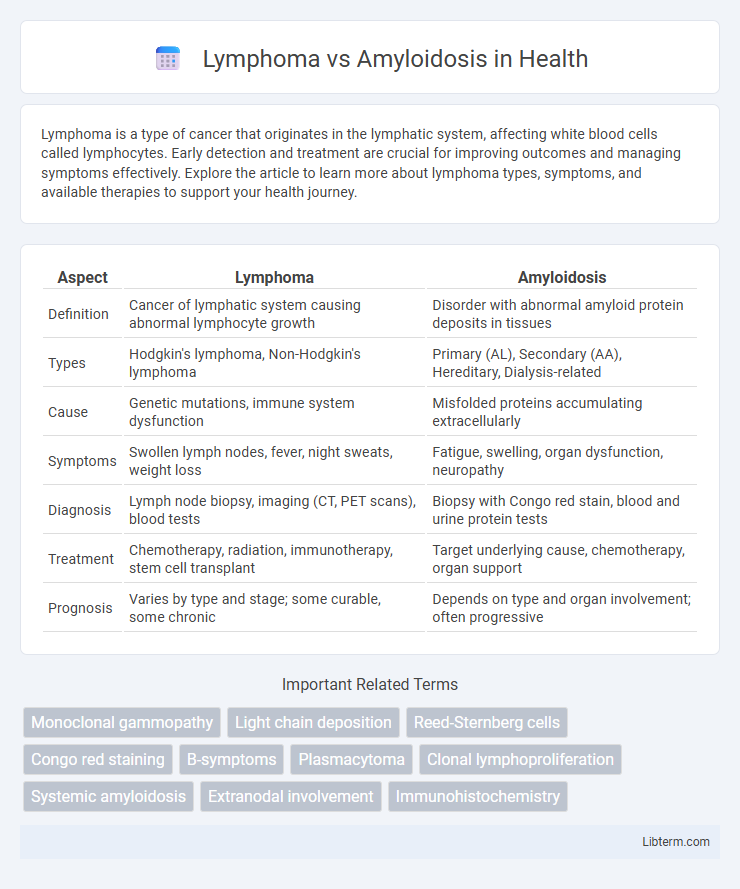Lymphoma is a type of cancer that originates in the lymphatic system, affecting white blood cells called lymphocytes. Early detection and treatment are crucial for improving outcomes and managing symptoms effectively. Explore the article to learn more about lymphoma types, symptoms, and available therapies to support your health journey.
Table of Comparison
| Aspect | Lymphoma | Amyloidosis |
|---|---|---|
| Definition | Cancer of lymphatic system causing abnormal lymphocyte growth | Disorder with abnormal amyloid protein deposits in tissues |
| Types | Hodgkin's lymphoma, Non-Hodgkin's lymphoma | Primary (AL), Secondary (AA), Hereditary, Dialysis-related |
| Cause | Genetic mutations, immune system dysfunction | Misfolded proteins accumulating extracellularly |
| Symptoms | Swollen lymph nodes, fever, night sweats, weight loss | Fatigue, swelling, organ dysfunction, neuropathy |
| Diagnosis | Lymph node biopsy, imaging (CT, PET scans), blood tests | Biopsy with Congo red stain, blood and urine protein tests |
| Treatment | Chemotherapy, radiation, immunotherapy, stem cell transplant | Target underlying cause, chemotherapy, organ support |
| Prognosis | Varies by type and stage; some curable, some chronic | Depends on type and organ involvement; often progressive |
Overview of Lymphoma
Lymphoma is a type of cancer that originates in the lymphatic system, specifically affecting lymphocytes, which are white blood cells vital for immune function. It is broadly classified into Hodgkin lymphoma and non-Hodgkin lymphoma, with the latter being more common and diverse in subtype. Diagnosis typically involves lymph node biopsy, imaging studies, and blood tests, while treatment options range from chemotherapy and radiation therapy to targeted immunotherapy depending on the stage and subtype.
Overview of Amyloidosis
Amyloidosis is a rare disease characterized by the abnormal accumulation of amyloid proteins in tissues and organs, leading to impaired function and potential organ failure. Unlike lymphoma, which is a cancer of the lymphatic system involving malignant lymphocytes, amyloidosis involves extracellular protein deposits disrupting normal cellular architecture. Early diagnosis of amyloidosis is critical, as the type and extent of organ involvement, such as cardiac or renal amyloidosis, determine prognosis and treatment strategy.
Causes and Risk Factors
Lymphoma primarily arises from genetic mutations in lymphocytes, often triggered by viral infections such as Epstein-Barr virus or human immunodeficiency virus, and is influenced by immune system deficiencies and exposure to certain chemicals. Amyloidosis results from abnormal protein folding and aggregation, commonly linked to chronic inflammatory diseases, multiple myeloma, and genetic predispositions related to transthyretin or light chain proteins. Both conditions share risk factors including age, chronic inflammation, and immune system dysregulation, yet their molecular causes and pathological mechanisms differ significantly.
Key Differences in Pathophysiology
Lymphoma is a malignant disorder characterized by the uncontrolled proliferation of lymphocytes, primarily affecting lymph nodes and other lymphatic tissues, driven by genetic mutations leading to abnormal cell growth and impaired apoptosis. Amyloidosis involves the extracellular deposition of insoluble amyloid fibrils, resulting from misfolded protein accumulation that disrupts normal tissue structure and function, often linked to chronic inflammation or plasma cell disorders. The key difference lies in lymphoma's neoplastic lymphocyte expansion versus amyloidosis's protein misfolding and deposition pathology.
Common Signs and Symptoms
Lymphoma commonly presents with painless swollen lymph nodes, unexplained weight loss, persistent fatigue, night sweats, and fever. Amyloidosis symptoms often include proteinuria leading to kidney dysfunction, peripheral neuropathy, and cardiac issues such as arrhythmias or restrictive cardiomyopathy. Both conditions may share systemic symptoms like fatigue and weight loss, but localized lymphadenopathy is more characteristic of lymphoma, whereas amyloidosis frequently affects multiple organs due to amyloid protein deposits.
Diagnostic Approaches
Lymphoma diagnosis relies heavily on imaging techniques such as PET-CT scans and biopsy for histopathological examination, including immunophenotyping and flow cytometry to identify malignant lymphocytes. Amyloidosis diagnosis involves tissue biopsy with Congo red staining to detect amyloid deposits, supplemented by serum and urine protein electrophoresis and immunofixation to characterize the amyloid type. Both conditions require distinct biomarker analysis to differentiate lymphoma's lymphoid malignancies from amyloidosis's protein misfolding disorders.
Staging and Classification
Lymphoma is classified primarily into Hodgkin and Non-Hodgkin types, with staging based on the Ann Arbor system evaluating the extent of lymph node and extranodal involvement, ranging from stage I (localized) to stage IV (disseminated). Amyloidosis is classified by the type of amyloid protein involved, such as AL (light chain) or AA (secondary amyloidosis), and staging relies on organ involvement and biomarkers like cardiac troponins and NT-proBNP for assessment of cardiac amyloid burden and prognosis. Accurate staging in lymphoma guides treatment intensity and prognosis, while amyloidosis staging prioritizes organ dysfunction severity, particularly cardiac impairment, to determine therapeutic options.
Treatment Strategies Compared
Treatment strategies for lymphoma primarily involve chemotherapy, radiation therapy, immunotherapy, and targeted therapy depending on the subtype and stage. Amyloidosis treatment focuses on reducing amyloid protein production through chemotherapy, stem cell transplantation, and supportive care to manage organ damage. While lymphoma therapies aim to eradicate malignant lymphocytes, amyloidosis treatment targets the underlying protein misfolding process and associated plasma cell abnormalities.
Prognosis and Survival Rates
Lymphoma prognosis varies widely depending on the subtype, with Hodgkin lymphoma showing a 5-year survival rate of approximately 86%, while non-Hodgkin lymphoma ranges from 60% to 70%. Amyloidosis prognosis depends on the type, with AL amyloidosis having a median survival of 1 to 3 years without treatment, whereas hereditary forms may have a longer prognosis. Early diagnosis and targeted therapies significantly improve survival rates in both lymphoma and amyloidosis, but organ involvement in amyloidosis often complicates outcomes.
Supportive Care and Patient Management
Supportive care for lymphoma centers on managing symptoms like fatigue, infections, and pain through tailored medications and nutritional support, while amyloidosis requires meticulous control of organ function, especially cardiac and renal health, using diuretics and symptom-specific therapies. Patient management in lymphoma includes regular monitoring of treatment response via imaging and blood tests, alongside psychosocial support to improve quality of life. In amyloidosis, personalized care involves frequent assessment of amyloid burden and organ impairment, with interdisciplinary coordination to address complex multisystem involvement and prevent complications.
Lymphoma Infographic

 libterm.com
libterm.com